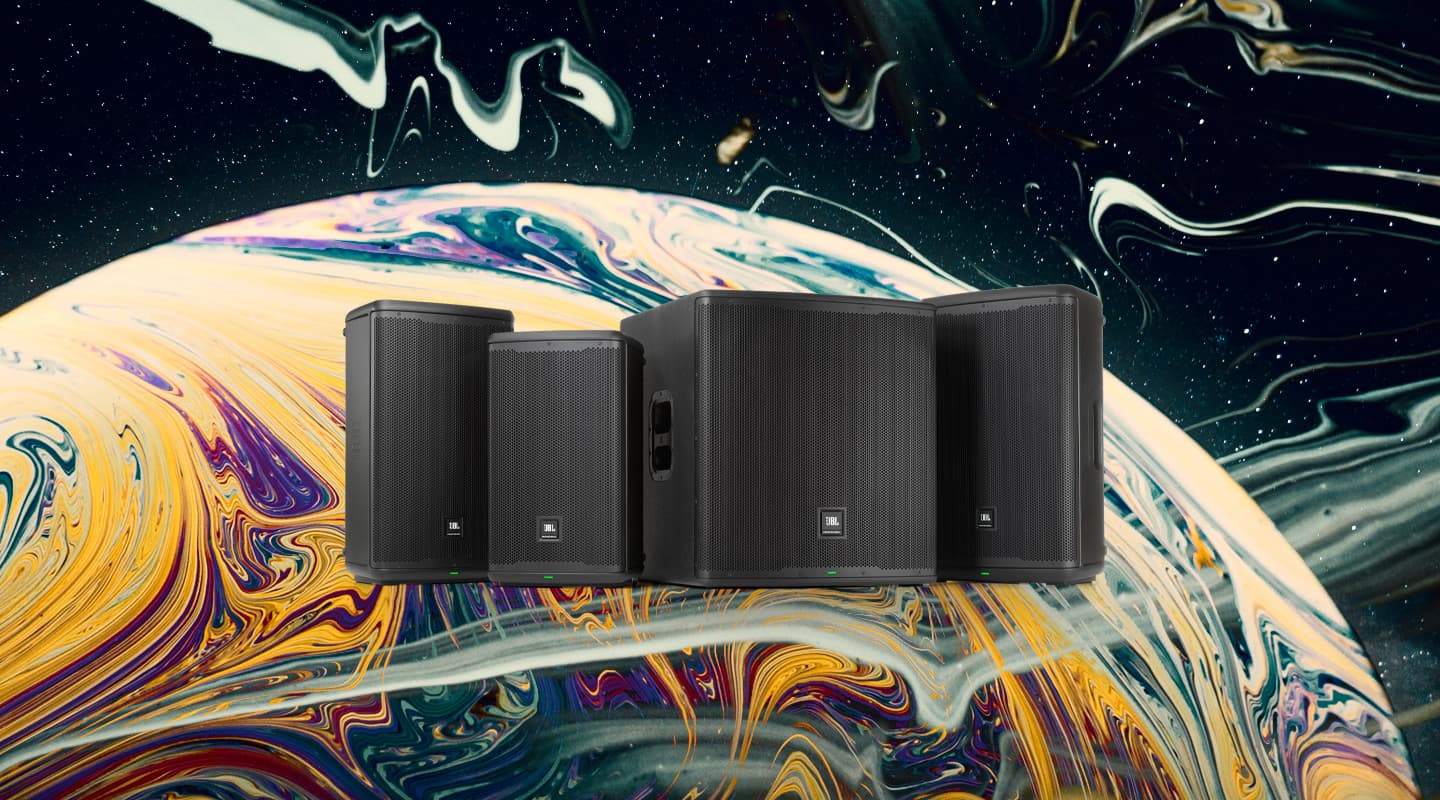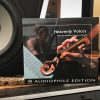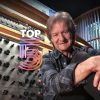
Review: JBL EON 712
The original powered moulded cabinet PA is still evolving.
The original JBL EON Series was the first to demonstrate that a reasonably-priced portable powered speaker could compete with black boxes and amp racks. Powerful enough for small- to medium-sized shows, easy to transport, simple to set up… they started a whole market segment.
Everyone makes their own version of EON now and prices range from a few hundred dollars to several thousand for the same size speaker with much the same intended purpose.
The EON range has retained its position as the leading brand by incorporating the latest tech as it evolves and getting the right balance between price and performance.
CABINET RESHUFFLE
The latest tech is particularly significant here as JBL takes advantage of tech from several well-known stablemate brands, directly contributing to the EON 700 Series design under their own name. More than a portable two-way, point-source, bass-reflex design with on-board processing and amplification, the EON 712 is also a showcase of how the concept has evolved over the last two and a half decades.
The original EONs had weird angles and shapes, the following 500 Series had them too but were more oval-themed. The EON 600 Series introduced the current, more contemporary look with a perforated steel grille front, flat sides with foldback angles and controls at the back. The EON 700 Series speakers refine this visual theme with cabinets made from talc-reinforced FEA-optimised polypropylene composite material, the talc (10%) adds strength and heat resistance, and contributes to the lightly textured, matte finish that looks professionally discreet and seems quite scuff-resistant.
The ergonomic handles on the top and one side are neatly integrated into the design with plenty of room to grab ‘em. Mounting options include four M10 eyebolts and holes for the EON700 Universal yoke mount for installations and a standard pole mount for pub gigs. A nifty feature sees the cabinet’s moulded feet shaped so they can be stacked on top of each other for storage.
The speaker looks more substantial than it weighs, the first time I grabbed a 14.6kg EON 712 by the top handle I instinctively felt there couldn’t be enough in it for professional performance, although it feels quite dead and resonance-free to the touch. The low weight is actually the happy result of the new cabinet materials giving more strength from less mass and a bit more stripping back of the internal components to leave only what’s absolutely needed.
The internal components are mainly new or improved. The two-inch voice-coil 712G 12-inch woofer is a new lower impedance/higher efficiency design. The slotted baffle across the front of the driver carries over from the EON600 Series. Slotted baffles are an old technique designed to improve the driver’s off-axis response by reducing beaminess that naturally increases as the frequency rises towards the crossover point. Traditionally these measures are hard to predict and implement, with the size and shape of the slots and the thickness of the baffle all play a part. Computer aided design and predictions have helped JBL get this baffle right.
The one-inch 2414H compression driver carries over from the previous 600 Series with a new horn design boasting improved off-axis response. Power comes from a single 650W RMS Class-D amp designed by stablemate Crown. A passive crossover at 2kHz separates the drivers. Cooling is passive — no fan; the back panel acts as a heat sink. I had them out in the full Aussie sun a few times and the cabinets certainly get hot but it doesn’t seem to bother them. Both sides of the cabinets are angled at the back with short protective feet so the speakers can be used on their sides as wedges on stage. I’m waiting for someone to make the little feet adjustable so you can alter the tilt angle — now there’s an idea. The horn is not rotatable but the speaker can be placed on either side as preferred, positioning the horns on the outside if using them as a pair for instance.
The rear panel has a major upgrade, including a colour OLED screen. The physical layout is minimal. Besides the screen there’s a soft power switch above a large Main Volume/Menu Navigation knob with a comforting Back button nearby. Below the screen there’s two Combi input channels with gain knobs and the expected XLR Pass Thru output. The speakers are set up to be driven from a mixing/DJ desk, the Channel and Master gain knobs are calibrated with 0dB (line level) max and there’s no mic/line switch. If you must plug a microphone directly into the speaker, pressing the Main/Menu knob gets you straight to gain settings for the two input channels and the opportunity to add up to 35dB of extra gain. A word of warning, the gain isn’t super clean, and there’s no 48V phantom power. no 48V. Take the hint: use a mixer with these speakers if at all possible.
NEED TO KNOW
JBL EON 712
Powered Portable PA
not quite a one-handed lift but close (old school roadies could have done it with one hand and a beer in the other)

This simple rear layout allows you to get the speakers up and working quickly without consulting the menu, and that’s good, but it’s not until you do explore the menu that you realise the full extent of the processing available backstage. After the gain settings the next menu item is Ducking by Soundcraft and it’s the first credited contribution from a sister company. It takes a minute to set up but it seems effective at turning the music down when the DJ speaks, with the ability to choose which mic channel is the sensor, the sensitivity of that channel, and how much the music is turned down. The corporate contributions continue with dbx DriveRack Output up next, and here you get dbx Automatic Feedback Suppression, EQ presets and a (2dB) bass boost. The EQ presets provide options based on different styles of music and environments, and might be useful for music playback applications. I found Flat works best for live music.
The Pass Thru & Time Align section is uncredited but powerful. Both the speaker itself and the Pass Thru outputs can be delayed up to 100ms — handy for turning them into instant delay speakers but there’s other situations with speakers close to each other where a tweak in time can improve phase relationships. Variable settings for ‘HPF on this speaker’ and a ‘LPF on the Pass Thru output’ create a useful crossover function when you’re using subs, and settings can be saved as a preset. The OLED screen is clear but under-utilised, in my opinion — the home screen is a bit empty and while simple level indicators on the channels show signal/clip, and there’s an overall Limit light, more detailed level metering would be useful and show off the new colours.


TURNED ON
In use, you can just turn the speaker on and it works, the voicing is smooth and friendly, more of a big hi-fi sound than a mid-forward monitor. The low frequency -3dB point is at 65Hz (-10dB@50Hz) and while they’re not super deep they’re full around 100Hz without being tubby around 160–200Hz and they like dance music. At high levels, the bass starts to squash up but they hold their sound and a pair could be used for smaller DJ/playback applications without a separate sub.
The midrange the response is within a few dB of flat with a slight scoop around 800Hz–1kHz. The high frequency response is slightly subdued around 3–4kHz before opening up to a shiny high end that extends to 20kHz (-3dB). This voicing avoids harshness at higher levels for music playback and also helps with their high resistance to feedback in foldback situations. The off-axis response contributes as well, it’s a guess trying to gauge the exact contribution of the slotted baffle but combined with the new 100° horn on the HF driver, the mid-range dispersion is wide and even across the front of the speaker.
SHOW TIME
The first time I used the EON 712s live was as a pair of floor monitors for singer Danielle Caruana from Mama Kin Spender. The band’s mixer Stephen Russell took control of them with his iPad and quickly had them up to a formidably strong and stable level for the vocal with plenty of her stomp box as well. The 100°(H) x 60°(V) horn is not rotatable but the 60 degree vertical dispersion angle is wide enough to provide good coverage with the speaker in its wedge position.
The next night saw a seated audience for Gabriella Cohen and band. With seats all the way to the front I needed a pair of in-fill speakers. The EON 712s were discreet and covered the first few rows easily, I used a little delay to feel how the fills worked with the main PA, because I could.
The most common use for this type of speaker is as FOH for small to medium shows/DJs but they need to be versatile. I’ve been doing a series of Sunday afternoon shows on a small outdoor stage in the middle of Maldon, in country Victoria. Over the weeks, depending on the weather, the act and my mood, the EON 712s have been used as FOH, delays and foldback. As FOH speakers for the smallest acts they have an easy-listening sound; they don’t throw as far as the modern array designs but they covered a couple of hundred audience easily. I’m sure they’re the lightest 12-inch loudspeakers I’ve ever put up on stands — not quite a one-handed lift but close (old school roadies could have done it with one hand and a beer in the other).


For the medium shows I enjoyed using the EON 712s as wedges and Melbourne folkie Sadie Mustoe was very happy with them when her turn came. Powered boxes on their sides give varied results but these are coherent with high resistance to feedback, I didn’t once think about or need the dbx AFS, nor did they need any EQ. I tried the Monitor preset and noted that I’d probably use it on a loud stage to reduce coupling and mud but outdoors with nice acoustic sounds, the Flat EQ was great.
Rich Davies & the Low Road was our biggest band, a rollicking folk act with lots of instruments and a lagerphone banging on the stage — he had them dancing in the street. I put up a EON 712 as a delay speaker at the last minute. Using an analogue mixing console, being able to set the delay time from the speaker was not only handy but the reason I was able to use it at all. It tricked me the next show, though, at sound check I had the band ask the unusual question: is there a delay on the monitors? There was, 48ms.
BLUETOOTH
I’d like to think the sound quality was the main criteria for judging or choosing a speaker but the first thing I’m usually asked if I mention a new speaker is ‘has it got Bluetooth?’ and, yes, the EON 700 Series does, Bluetooth 5.0 in fact, and despite my reservations about the fidelity of compressed files being Bluetoothed, this sounds pretty good in an EDM kinda way.
The tech keeps coming with the JBL Pro Connect mobile app, designed to control a wide range of JBL models from different series with a smartphone or tablet. When paired, BT Control gives access to level and some more precise EQ than the presets provide. The app itself wasn’t fully resolved in time for my review (on my GalaxyA21 anyway) but I’ve been assured that the bugs have been or are being ironed out.
Also available is the EON 710 and EON 715, with smaller and larger LF drivers respectively, and the EON 718s powered sub-woofer to complete the range. Overall these are very good speakers and offer great value for DJs and bands. The DSP is the key to the speaker’s performance, including a few ‘surprise and delight’ features from sister companies. There are speakers with more power, bigger voice coils and multi-amps but they cost twice as much. There’s a world of cheaper speakers out there but I wouldn’t bother, the EON Series is entry-level professional gear with the sound and build quality to always work and last the distance. The EON712 is the latest version of a classic speaker and it comes with the lot.
























We bought a pair for live medium indoor & outdoor FOH. We can’t get enough volume out of them unless they’re clipped. Our Mackie subs can be pushed further without clip, but the 712’s are making us pull our hair out.
Jbl 2 top pf 15 inch in eon
Two small base which requires for these top
I’m having the same issue. I use them for small indoor and outdoor dj gigs. I was taught to turn gain and master up on my dj mixer first, then the pa. But when I do this, they clip at a very low to almost no volume. So I have to turn the pa main volume and channel gain up with my dj mixer gain and master turned down to get any sound loud enough. Still trying to figure this out.
Have you figured out the gains yet?
I have been searching for a clear explanation between the THREE different ways to affect gain/volume from the rear LCD screen
From the rear lcd screw you won’t find much. The app will let you balance the equalizer how you want. It’s not the easiest at first but once you get it down your main volume and gain are lower.
Hi Mark,
Great review!
The JBL EON 712 is an outstanding piece of equipment! It delivers exceptional clarity, a well-rounded sound (including delightful bass tones), and is incredibly user-friendly.
Regards
Steve